Table of contents
- Why do browsers use so much memory?
- Lowest RAM usage browsers
- 1. Microsoft Edge
- 2. Opera
- 3. Brave
- 4. Chromium
- 5. Mozilla Firefox
- 6. Google Chrome
- 7. Safari
- Best browser for low-end PC
- 1. K-Meleon
- 2. UR Browser
- 3. Midori
- 4. SeaMonkey
- 5. Lynx
- Browser's performance comparison
- Conclusion
Why do browsers use so much memory?
Browsers use a lot of memory because of all the processes behind the scenes. A quick look at your task manager will show you how much CPU browsers use, even when you aren’t doing much.
If you’re wondering what the CPU has to do with RAM, the answer is simple. The central processing unit (CPU) works in tandem with RAM. It receives its data and instructions and carries out operations on the items stored in RAM.
Microsoft explained that many browsers are based on a multi-process architecture, which significantly impacts performance. Browsers’ memory usage comparison shows that different platforms allocate resources differently, affecting speed and efficiency. These are the processes they carry out daily:
- Browser process, the main process, helps organize the tabs and windows you open, the address bar, and more.
- Renderer processes execute the code provided by websites to render them in tabs. They’re responsible for images, HTML, CSS, JavaScript, and more.
- GPU process carries out GPU (graphics processing unit) tasks and communicates with the GPU. It helps browsers render web pages quickly.
- Utility processes handle video capture, audio playback, data decoding, network service, and collections manager.
- Plug-in and extension processes. The former executes code provided by active plug-ins, like Adobe Flash, while the latter executes code provided by active extensions. The code provided informs of the amount of resources used, so no two processes use the same amount. The codes of plug-in and extension processes also facilitate communication between the plug-ins, extension, and the browser, as well as renderer processes.
- Crashpad handler process maintains the health of the various processes by reporting crashes to the browser’s servers. The reports help identify and fix crashes.
Your browser collects data about you and your activities. It’s also a breeding ground for cybercriminals hiding behind malicious websites to track and steal your personal information. You’ll know you’re being tracked when you start seeing online ads based on what you searched for online or talked about with a friend.
If you want to use the internet safely, try a tool that protects you while browsing. Clario AntiSpy’s Safe browsing is an anti-tracking solution that offers various tools to protect your data:
- Ad blocker ensures you don’t encounter annoying online ads by blocking them before they get to your browser.
- Anti-tracking software stops advertisers and other data collectors from tracking your online behavior and accessing your personal data for targeting.
- Phishing protection keeps you away from malicious websites to avoid getting scammed.
On a Mac, Clario AntiSpy’s Safe browsing works as a Chrome extension. On a Windows device, it’s a built-in tool. Here’s how to use it:
- Download Clario AntiSpy, get a subscription, and set up an account.
- Select Safe browsing in the sidebar. On a Mac, click the Install button and follow the prompts to add the extension to Chrome.
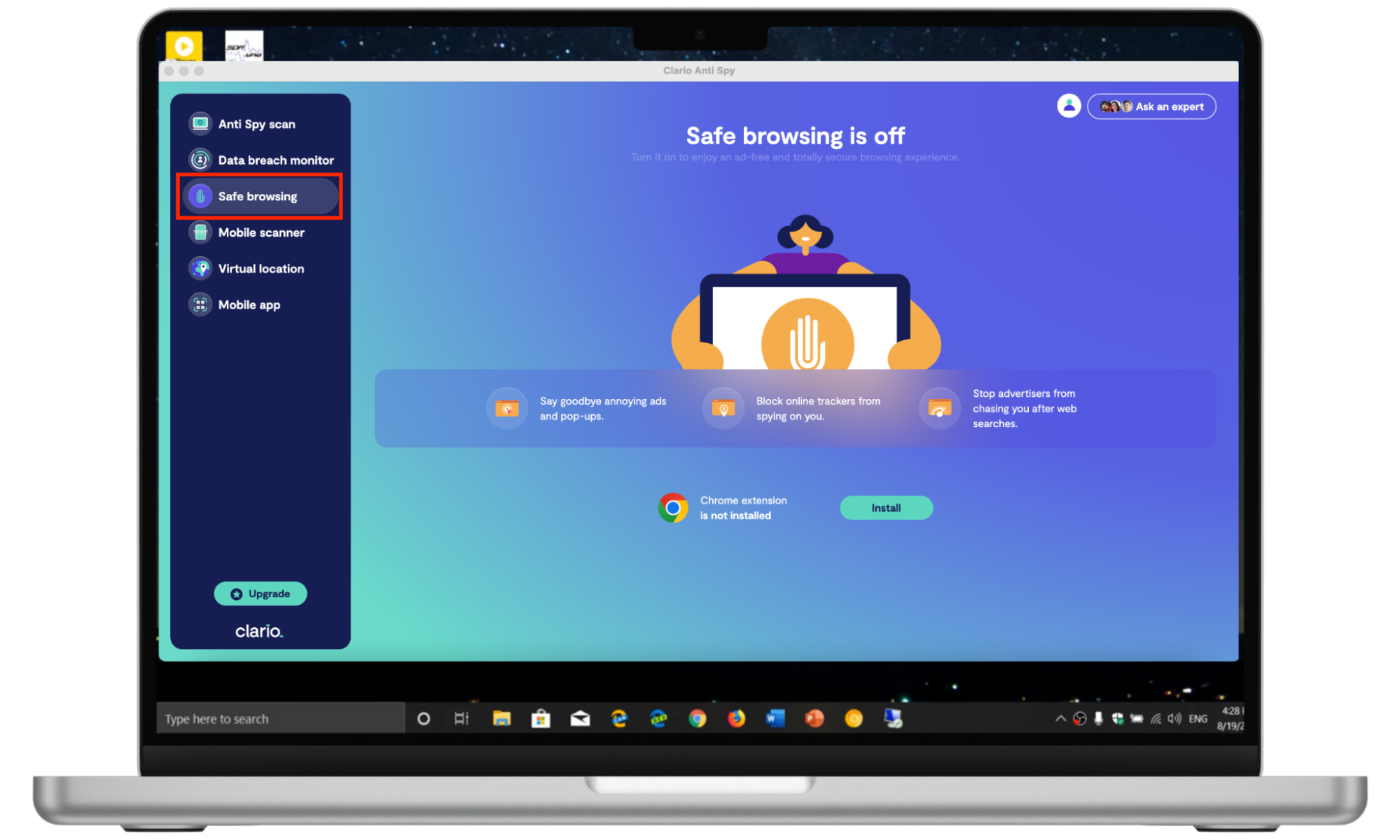
Lowest RAM usage browsers
Are you looking for low-memory browsers? Here’s a list of seven browsers that use the least RAM:
- Google Chrome
- Opera
- Safari
- Microsoft Edge
- Mozilla Firefox
- Brave
- Chromium
Below is how the browsers compare when it comes to RAM usage.
Note
These figures are based on an experiment where each browser is running 10 open tabs.
| Browser | RAM Usage |
|---|---|
| Microsoft Edge | 790 MB |
| Opera | 899 MB |
| Brave | 920 MB |
| Chromium | 930 MB |
| Mozilla Firefox | 960 MB |
| Google Chrome | 1000 MB |
| Safari | 1200 MB |
1. Microsoft Edge
If you’re wondering which browser uses the least RAM, Microsoft Edge is a top contender. Thanks to its efficient memory management, it outperforms many competitors in terms of resource usage.
Granted, Microsoft Edge isn’t the most popular browser, claiming only 10% of the market share in the US, according to Statista. However, there’s a reason why it’s still around. For one, it was reintroduced as a Chromium-based browser with Blink and V8 engines in 2020, which made it less buggy. More importantly, it’s the lightest on memory.
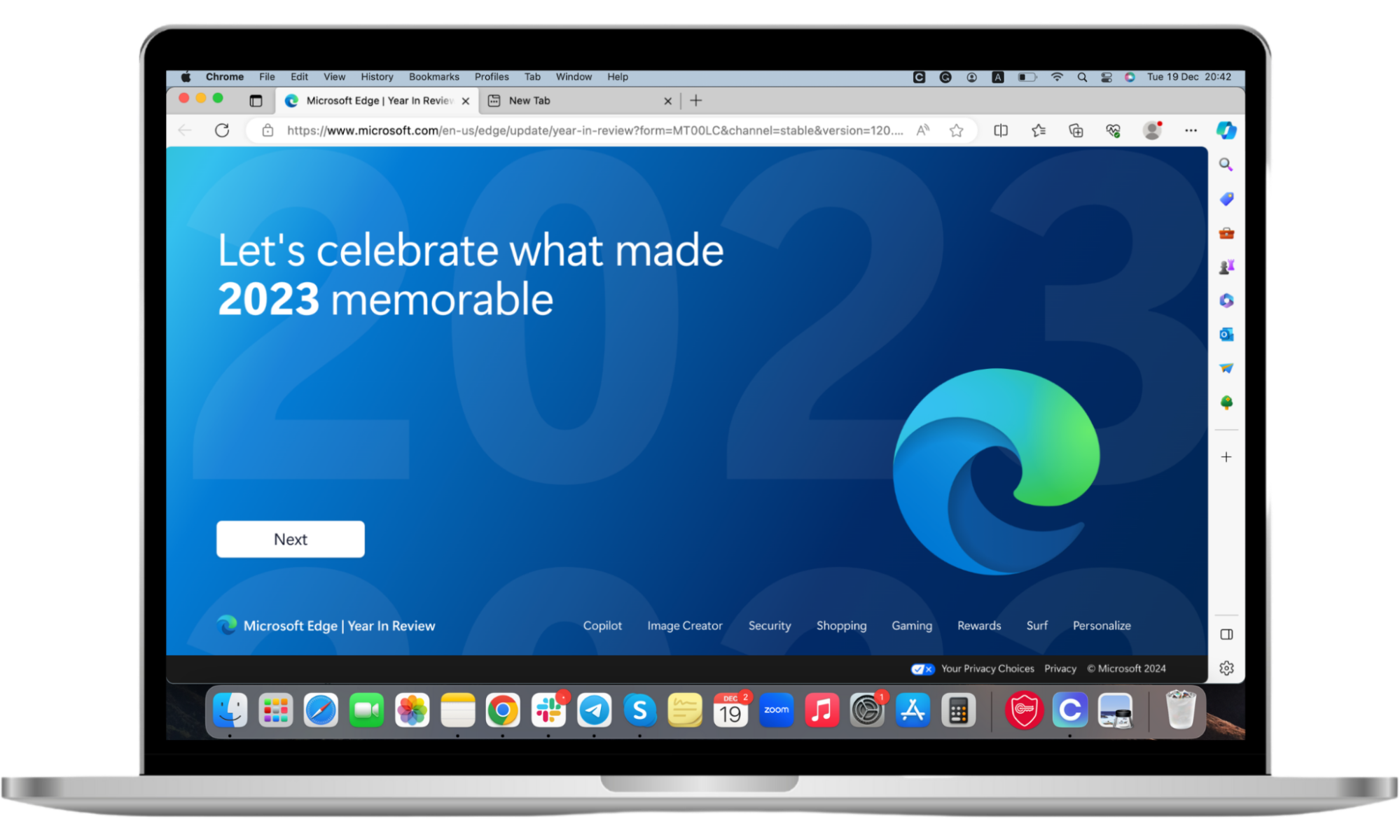
Microsoft Edge takes up only 790 MB of memory with 10 tabs open, which is the lowest and most impressive of all the browsers on our list. With 20 tabs open at once, the browser takes up 1.2 GB of RAM. Impressive!
Microsoft Edge has figured out how to optimize browser memory consumption. One of its significant features in this regard is Sleeping Tabs, although it isn’t unique to Edge. Through this feature, Microsoft Edge automatically puts tabs to “sleep” when they’ve been idle or you haven’t used them for an hour. However, you can change the time before tabs go to sleep—from 30 seconds to 12 hours. The lower time ranges are ideal if you want to use Edge as a low-resource browser.
The Sleeping Tab feature boosts your browser’s performance by freeing up system resources like CPU and memory for those tabs you are using at the time.
2. Opera
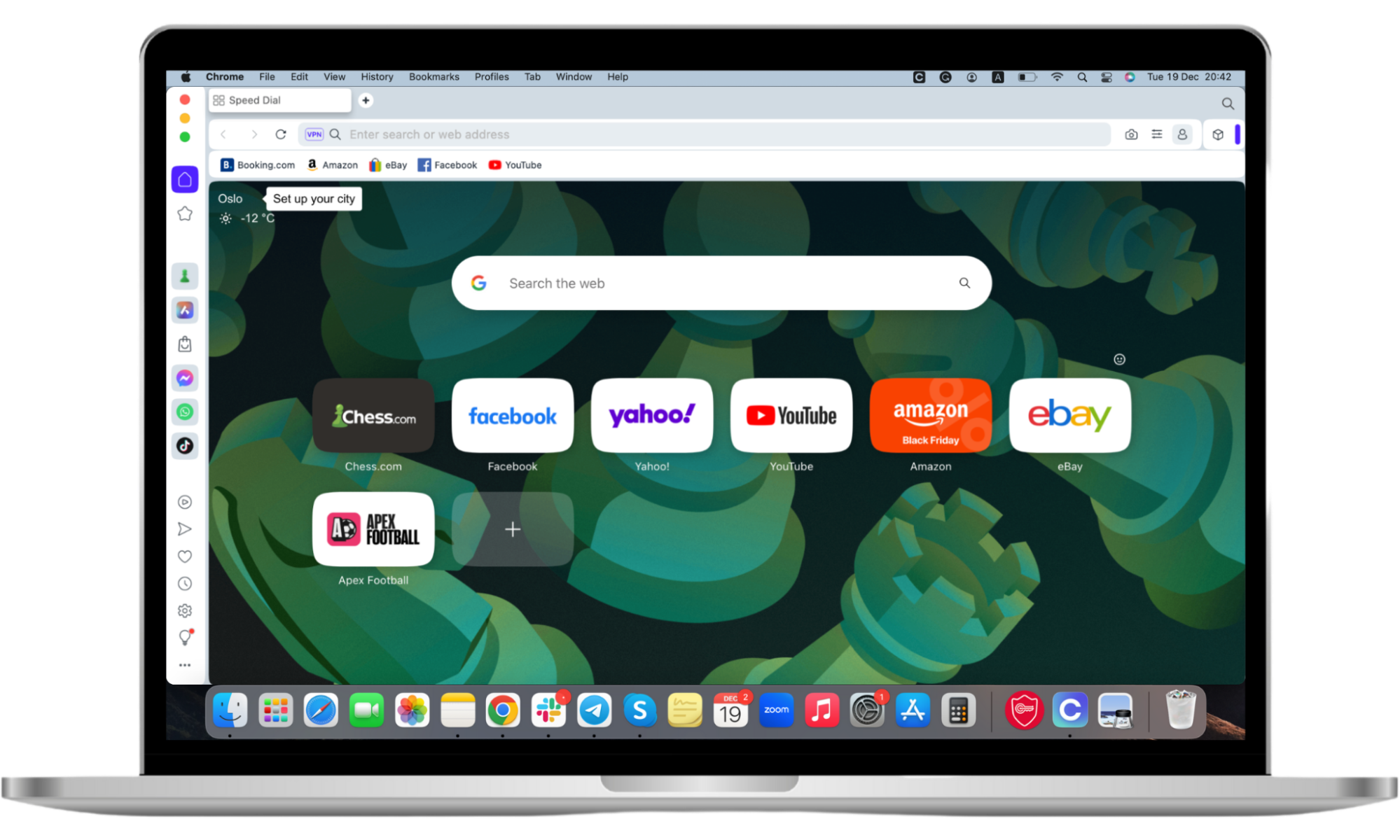
Though it may not seem that way now, Opera was once one of the most popular browsers, having peaked in 2015. Today, it’s still one of the preferred browsers for low-spec or older computers for various reasons:
- It’s lightweight and easy on the system
- It has good enough webpage-loading speeds
But how far does it go against other browsers in terms of RAM usage?
Opera is another low memory usage browser, consuming 899 MB of RAM with 10 tabs open. With 20 tabs open, Opera uses 1.5 GB of memory. This is higher than expected, given how lightweight Opera is. However, while 899 MB of RAM is high, it’s still 101 MB less RAM than Google Chrome.
3. Brave
Some people know about Brave; some don’t. Brave is one of the new kids on the block, released on November 13, 2019. Brave is an open-source, privacy-minded web browser based on the Chromium browser. It’s also quite unique and ideal for people looking for something different in a browser, as it offers essential and convenient privacy and other tools.
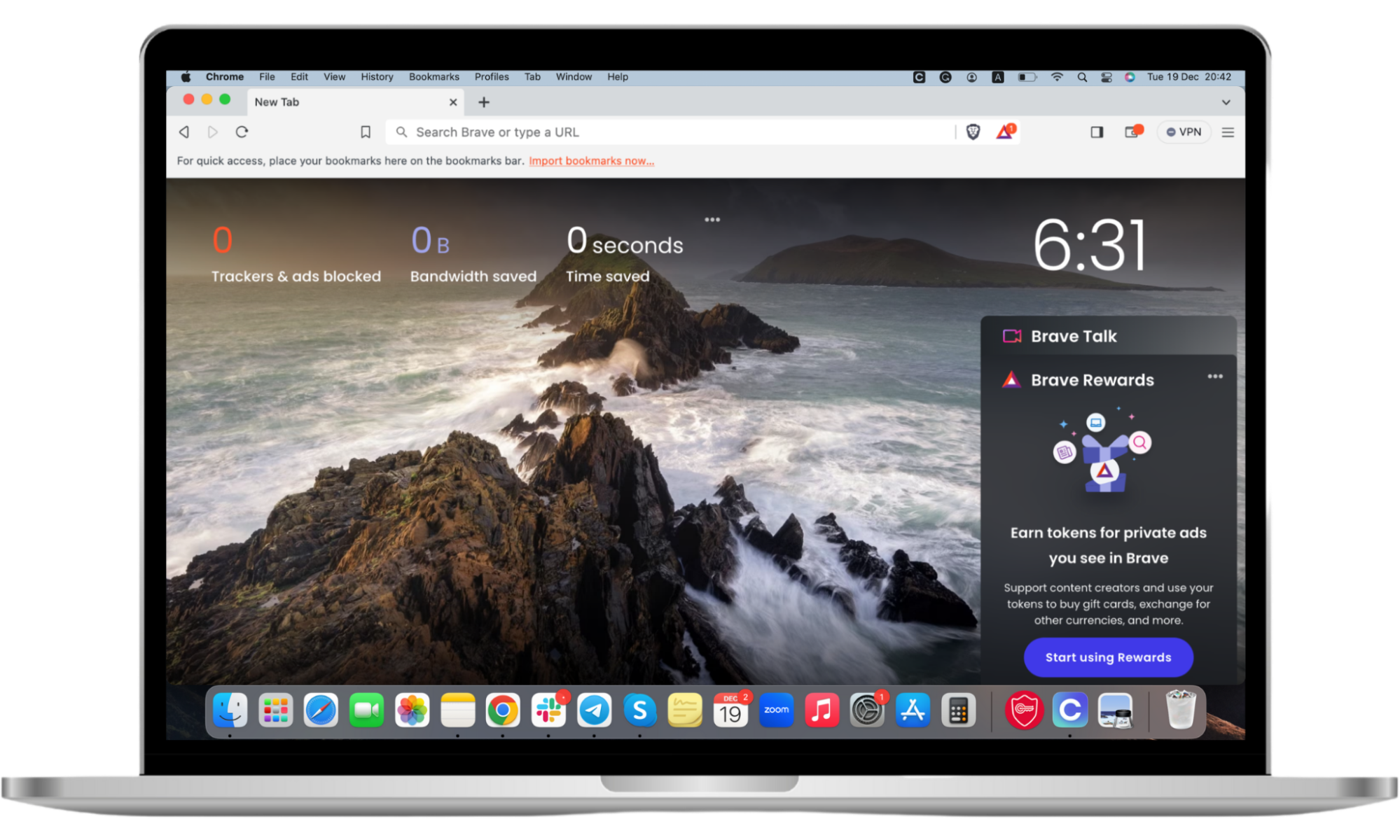
Here are some of its features and benefits:
- Brave rewards you for watching non-invasive ads without compromising your privacy. This means that both you and the advertisers benefit from ads. It’s an enticing trade-off, given how annoying ads typically are.
- It offers a VPN service that protects up to five devices, including iOS and Android phones.
- It prevents online tracking by blocking phishing, fingerprinting, cross-site cookies, and trackers by default; no enabling is needed.
- It blocks third-party ads.
But what about RAM usage? Brave takes up 920 MB of RAM. While this isn’t the worst RAM-consuming browser, it isn’t the most efficient either. So, while there are many good reasons to use Brave, RAM efficiency isn’t one of them.
4. Chromium
Chromium is an open-source web browser project that is the foundation of various browsers, including Google Chrome. Because it’s open source, developers can use it to create custom browsers that others can enjoy.
Below is a list of Chromium-based browsers:
- Brave
- Microsoft Edge
- Vivaldi
- Opera
- Epic
- Comodo dragon
- Ungoogled-chromium
- Avast Secure Browser
- SRWare Iron
- Yandex
- Blisk
- Chromium Icon
- SlimBrowser
- Torch
- ARC
Have you ever wondered why Chromium-based browsers are so popular? The answer is simple. The Chromium open-source project focuses on delivering a faster, safer, and more stable web browsing experience.
Resource optimization is another significant factor in Chromium-based browsers. They achieve this through advanced memory management techniques. Additionally, they utilize memory efficiently. Don't forget that they’re compatible with a wide range of extensions. This allows users to improve their browsing experience.
Chromium offers a more stable and safer way to use the web. Chromium uses 930 MB of RAM, so it isn’t exactly a top pick for RAM usage. However, there are instances when you’d choose Chromium over Chrome, or at least consider it:
- If you like Chrome’s interface, you might enjoy using Chromium. It has a user interface that’s similar to Chrome.
- If you’re a Chrome user looking for a more memory-efficient browser but nothing too different, Chromium is a good option. However, it’s not light on RAM.
5. Mozilla Firefox
There are many reasons to love Firefox, the main one being its commitment to helping you browse privately. nSecurity is one of Firefox’s top features. The browser protects your personal information from potential hackers, which makes it ideal for anyone who cares about their online safety.
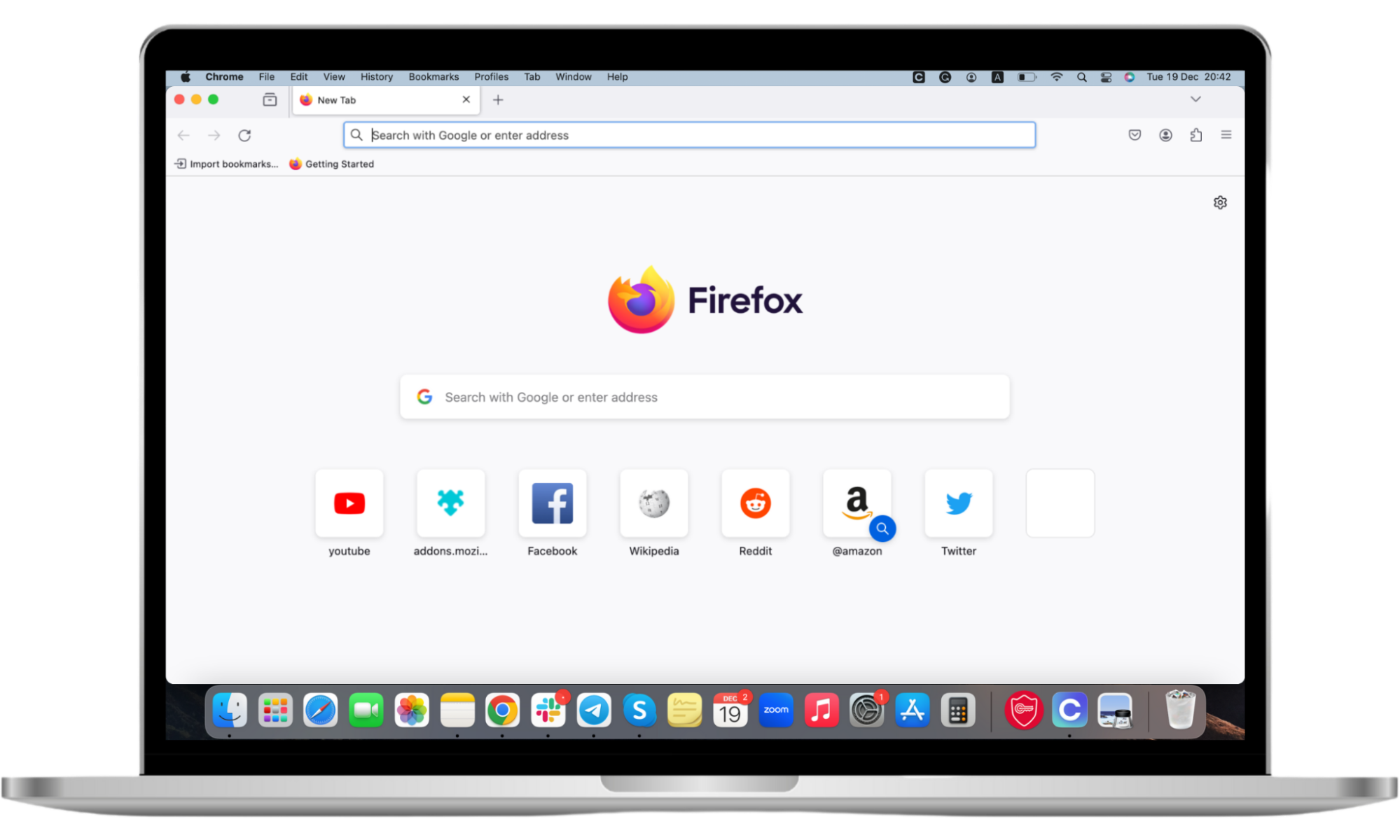
Mozilla Firefox also delivers fast speeds for a smoother browsing experience. This includes loading pages quickly, even on devices with less powerful processors.
Its efficiency is another notable feature, thanks to its Quantum engine, which reduces CPU usage. Firefox operates tabs independently, which optimizes the browser in several ways:
- It keeps it stable and prevents it from crashing.
- It allocates memory to tabs separately and limits RAM usage when resources are low.
Be that as it may, Mozilla Firefox isn’t light on RAM. Firefox uses about 960 MB of RAM with 10 tabs open, which is only slightly less than Chrome. It’s not the worst on the list, but it’s still up in the 900 MB range, which is a lot of memory. When you open 20 tabs, the memory reaches 1.6 GB of RAM.
6. Google Chrome
Google Chrome is the most popular browser, accounting for 59% of the market share for desktop browsers in the US, according to Statista. And for good reason—it’s efficient, secure, fast, and user-friendly. However, Google Chrome is known to use a lot of RAM—about 1000 MB if you have 10 tabs open.
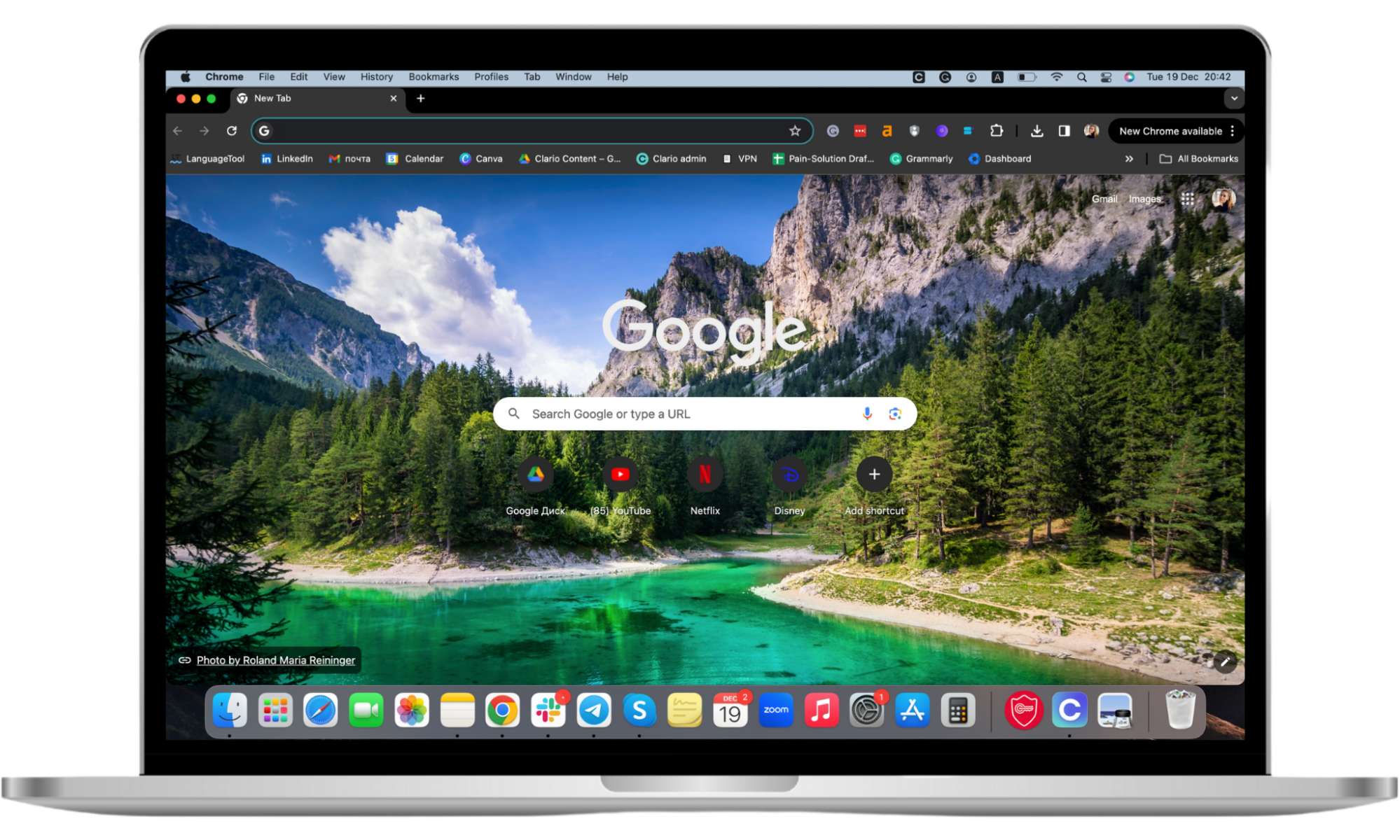
By no means does it use minimal RAM. In fact, it’s one of the top two RAM guzzlers on our list. You can limit the number of tabs you have open at a time to use less RAM. However, this is neither practical nor realistic, as the average person has between 5 and 10 tabs open at a time.
Subsequently, the more tabs you have open at once, the more RAM you use. For example, if you have 20 tabs open, Chrome uses a whopping 1.9 GB of RAM, which is excessive. Not only that, but Chrome also consumes a ton of CPU resources, so it is likely to affect your user experience. Having too many tabs open can negatively impact your laptop’s efficiency. In the worst-case scenario, it can cause your computer to crash.
7. Safari
Safari is a straightforward browser that offers a smooth experience. Its simple user interface makes it possible to access important information quickly and easily. One of its downsides is that it’s an Apple browser, so it’s only available on devices in Apple’s ecosystem, like MacBook devices, iPhones, iPads, etc.
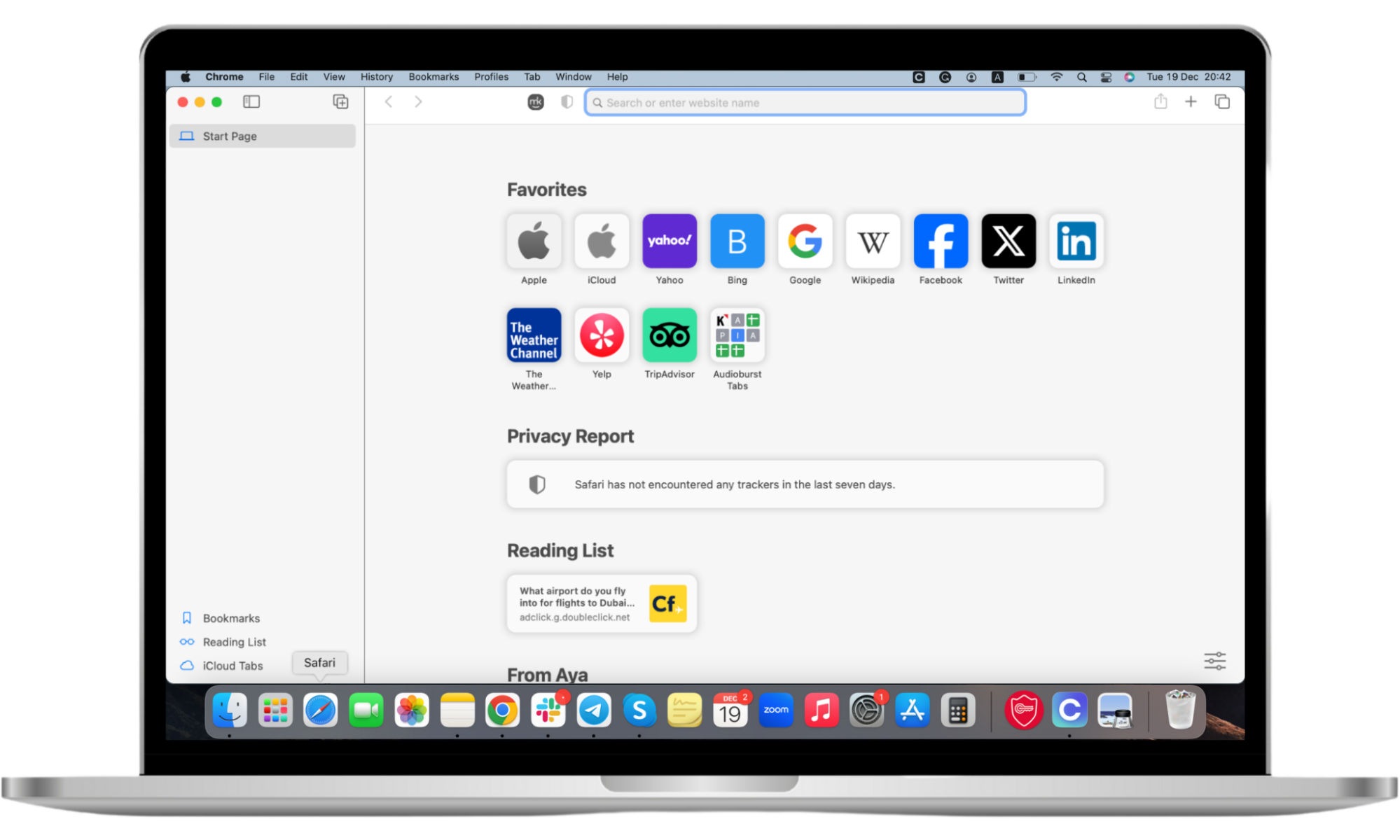
As for RAM, Safari came in last on our list of low-RAM browsers, taking up 1200 MB with 10 tabs open. If you’re concerned about memory, this isn’t a browser you’d use. Of course, if you use a Windows device, you don’t have to worry about that.
Best browser for low-end PC
Do you own or use a low-end PC? Then, the browsers listed below are best suited for your device.
What is a low-end PC?
A low-end PC is one that doesn’t have all the bells and whistles that high-end PCs do. Typically, it has less than 16 GB of RAM and weak performance. It also has an i3 or Ryzen 3 processor.
1. K-Meleon
This is a free, open-source browser with a lightweight interface. Even though it’s lightweight, it doesn’t compromise on performance. More importantly, it has low RAM usage, around 20 MB per tab, thanks to its Gecko layout engine. These are some reasons why K-Meleon is considered one of the top picks for low-end PC users.
You must have a Windows XP-SP3 or a later version to run K-Meleon. Moreover, it has a large online community in case you need support.
| Features | |
|---|---|
| Plug-ins | There are a ton of plug-in options that are missing in the default browser |
| Customization | You can tailor the browser to your liking, including changing skins and customizing keyboard shortcuts, the main menu, and context menus. You can also drag and drop or disable toolbars |
| Lightweight | The browser can run on 20 MB of RAM and uses under 100 MB of memory to render webpages |
| Quick search | K-Meleon allows you to search directly from the URL bar using quick search bookmarks and Mozilla-style keywords |
| Legacy operating systems | K-Meleon can be used on Windows XP and Windows Vista. It supports ReactOS, Windows Server 2003, and Windows 7 up to the latest version |
| Pros | Cons |
|---|---|
| K-Meleon is privacy-focused. It features a memory-light ad blocker. It also allows you to use proxies and manage cookies. | It lacks other common features, such as a mail client and an HTML editor. |
| The browser has fast speeds. | You’re likely to run into websites with bad code. |
| It renders pages flawlessly. | The browser is only available for Windows devices. |
| Plug-ins make up for missing options. | |
| It uses very little RAM, even with many tabs open. | |
| It uses less CPU resources for rendering compared to Firefox’s original interface. |
2. UR Browser
UR Browser is another modern browser for low-end PC users. It has a simple, sleek, modern user interface that is easy to navigate. Unlike other browsers for low-end computers, this one supports macOS devices.
| Features | |
|---|---|
| Privacy | With the UR Browser, privacy is the name of the game. It blocks the following for a peaceful and efficient browsing experience: trackers, cookies, and targeted ads. Furthermore, it offers different levels of privacy—low, medium, and high. This allows you to customize your experience depending on the website you’re on. The browser also allows you to save your privacy preferences for specific websites. When you do this, the websites load at your chosen privacy level |
| Speed | UR Browser is one of the fastest browsers on the market. If that sounds like your thing, this browser is for you |
| Pros | Cons |
|---|---|
| It gives you the ability to choose your security tools. | The browser is still in beta at the time of writing this article. |
| It includes a built-in virus scanner. | |
| It is privacy-focused. | |
| Using the browser on medium-level privacy improves the speed. | |
| It protects your device from online threats. |
3. Midori
Midori is a low RAM and CPU usage browser, similar to K-Meleon. It supports various devices, including Linux, Android, and Windows, with plans to be released on Mac devices in the future. It’s a customizable browser that allows you to play around with icons, visual aspects, and functions.
The browser has integrated cloud storage, offering you 5 GB of free storage to save space on your computer.
At the time of writing, Midori is in the development stages of a free VPN, which will be available in the following countries:
- United States
- Canada
- Germany
- Germany
- Finland
- China
- Netherlands
- France
- New Zealand
If you’re interested in the VPN service and are in one of these countries, you can join the waitlist.
| Features | |
|---|---|
| Customization options | You can change the design and appearance of the interface to your liking |
| Advanced tab management | The browser allows you to group tabs and add them to workspaces |
| Lightweight | While Midori is lightweight, it doesn’t lose its functionality |
| Pros | Cons |
|---|---|
| It’s a fast browser. | The user interface is unfamiliar. |
| It allows you to use web apps. | It doesn’t work efficiently for some Google web apps. |
| It has useful plug-ins built into it. | Updates are inconsistent. |
4. SeaMonkey
SeaMonkey is not a browser per se. Rather, it’s an application suite that includes an open-source browser. The open-source code gives you a lot of control over the browser's tools and functions. The community chips in to help enhance and maintain the project. But that’s only helpful if you’re tech-savvy.
The browser itself is very lightweight. At just 40 MB, it uses minimal storage space and requires very few resources to run on your PC. SeaMonkey uses the optimized Mozilla base code. However, it omits many of the weighty added features that Firefox has.
If your computer runs the legacy Pentium processors, you can use SeaMonkey. Ensure you have at least 1 GB total RAM for a smooth experience. The browser has a restore session feature that comes in handy when your computer crashes.
| Features |
|---|
| It allows you to drag and drop tabs and add bookmarks with the same action |
| You can customize certain elements, like the default font |
| It includes an email client, an HTML editor, and built-in chat features |
| Pros | Cons |
|---|---|
| SeaMonkey is a comprehensive internet suite offering more than just a browser. | SeaMonkey has a dated user interface, which is not well-liked by all browser users. |
| The browser requires minimal resources to function. | Slow startup speed can be annoying, frustrating, and sometimes time-consuming for users. Learn what to do when your Mac is running slowly. |
| It is lightweight and not memory-intensive, so you don’t have to delete important files and software to make room for it. | New add-ons are not released consistently. |
| The latest version has all the features one can expect in more modern and popular browsers. For example, SeaMonkey has an integrated search engine, pop-up blockers, and tabbed browsing. | The suite is very basic. |
| It includes privacy features, like the privacy browser setting. This setting masks your history while you work online. | The browser lacks the default search box, which is present on the home page of most browsers. |
| SeaMonkey supports Firefox themes and extensions. | |
| It can be synchronized across devices. |
5. Lynx
Launched in 1992, Lynx is one of the oldest browsers still being maintained. Lynx is a different kind of browser. It’s a customizable, text-based browser, so it’s not for everyone. It’s suitable for back-end developers and coders. You can run Lynx on the following systems:
- Un*x
- VMS
- MacOS
- OS/2 EMX
- Windows 95/98/NT, DOS386+ (except for not 3.1, 3.11)
| Features |
|---|
| Lynx is highly configurable |
| It is compatible with older computers |
| It supports SSL and many HTML features |
| It supports web scraping and automatic data entry |
| It’s ideal for accessing websites from a remotely connected system without a graphical display |
| Lynx is compatible with text-to-speech software and can be used by visually impaired users on a refreshable braille display |
| Pros | Cons |
|---|---|
| The browser lacks promotion. | Given that it’s text-based, Lynx is not for everyone. |
| It’s free, safe, and fast. | It lacks the most basic features that are present in most modern browsers. |
| It’s multilingual, catering to a wider audience. | It lacks support for JavaScript, which means some pages can’t run on the browser. |
| It has minimal user tracking. | Lynx is not ideal for visiting modern websites. |
| It allows you to focus on what you’re reading without distracting images. |
Browser's performance comparison
When considering RAM usage, Microsoft Edge stands out as the internet browser that uses the least RAM. At 790 MB with 10 tabs open, it outruns other popular browsers, making it the lowest memory browser among mainstream options. Safari uses the most memory—1200 MB if you pen 10 tabs. Most popular browsers are in the 900 MB range, including Mozilla Firefox, Brave, and Chromium.
Conclusion
You consider several factors when choosing the right browser for you. This looks different for each user, as everyone has different needs and preferences. However, some factors typically apply to all users, like user-friendliness, interface, safety, security, privacy, and RAM.
If you’re concerned about how much memory browsers use, our handy guide should help you easily compare popular browsers. We’ve also included other key features of each browser. This should allow you to compare them alongside the memory element to help you decide. Whatever decision you make, ensure you use Clario AntiSpy’s Safe browsing tool to protect yourself from online trackers, targeted ads, and phishing.


